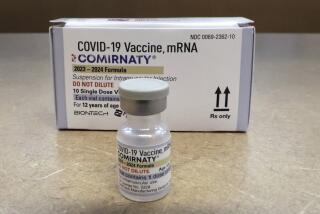Intense Cholesterol Care Urged in High-Risk Cases
- Share via
WASHINGTON — Individuals who have high cholesterol counts and display other risk factors for heart disease should receive aggressive therapy targeted at the low-density lipoprotein, or “bad” cholesterol, in their bloodstream, a federal panel recommended Tuesday.
Dietary changes, weight loss and exercise are the therapies of choice for lowering cholesterol, the panel reported. Drugs should be regarded as a last resort, especially in adults who have high levels of high-density lipoprotein, or “good” cholesterol, and are otherwise at low risk for heart disease.
In an accompanying report, the National Center for Health Statistics said average blood cholesterol levels in the United States have dropped significantly in the last 12 years. This reflects a trend that began in 1960 and parallels a continuing decline in heart disease. Both reports appear in this week’s issue of the Journal of the American Medical Assn.
High cholesterol is a risk factor for heart disease, the nation’s leading killer of men and women. About 500,000 Americans die annually from heart disease and an estimated 52 million have high cholesterol levels.
Cholesterol is a fatty substance found only in animal products. Saturated fats, which can be found in non-animal products, are turned into cholesterol by the body.
The report by the National Cholesterol Education Program, a panel convened by the National Heart, Lung and Blood Institute, is an update of its first set of treatment guidelines released in 1988. The guidelines are used as a standard for the nation’s physicians in determining the best form of therapy for patients with high cholesterol levels.
The new recommendations “reflect the increase in scientific knowledge over the past five years,” said Dr. Claude Lenfant, director of the heart institute, which is part of the National Institutes of Health.
The panel stressed the importance of distinguishing the levels of low-density lipoprotein (LDL) and high-density lipoprotein (HDL) in patients. Physicians should test for both kinds of cholesterol, it said. A high level of HDL is a “negative” risk factor, meaning that it helps reduce the chances of developing heart disease.
A total cholesterol reading lower than 200 milligrams per deciliter of blood is classified as “desirable,” while a level of 200 to 239 is considered “borderline high” and a reading greater than 240 is regarded as “high.”
An HDL level higher than 60 is considered desirable, the group said.
Despite its preference for dietary and exercise therapies, the panel said patients who face the most immediate risk of heart disease should receive “the most aggressive therapy,” including drugs if necessary.
Besides high cholesterol, risk factors include a family history of heart disease at an early age, smoking cigarettes, high blood pressure, an HDL count below 35, diabetes, obesity and physical inactivity, it said.
For the first time, the panel recommended considering age as a risk factor, stressing that the dangers of developing heart disease increase with age, particularly among post-menopausal women.
Men older than 45 and women older than 55 should be considered at greater risk for coronary disease and warrant more aggressive therapy for high cholesterol, the panel said. In addition, women who have undergone premature menopause and who are not taking estrogen hormone replacement therapy should be considered among those at greater risk and may need more aggressive treatment at an earlier age, the group said.





